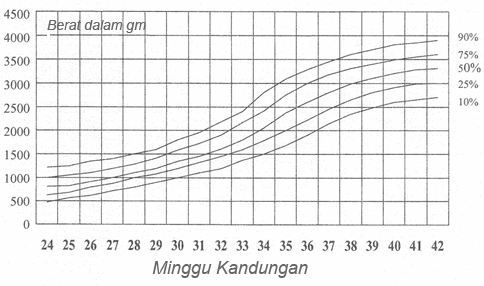Large For Gestational Age (LGA)
- Birth weights are more than 90th percentile for their gestational ages (number of weeks of pregnancy).
- These babies weigh more than 90% of all other babies of the same gestation .
- Babies whose weight fall in the area above the 90% line in the intrauterine growth chart – refer to diagram.
- Generally a full term infant of > 4kg birthweight is an LGA baby.

What are the causes of LGA?
A number of causes have been identified. They include :
- Uncontrolled Gestational Diabetes – diabetes during pregnancy
- This is the most common cause of LGA babies.
- A mother’s excessive blood sugar levels can cause increased blood sugar to circulate to the baby. In response, the baby’s body will increase production of insulin. All these excessive insulin and blood sugar will lead ti increased fat content and increased growth in the baby.
- Genetics – babies with obesity parents (high BMI)
- Excessive weight gain in mothers during pregnancy
What are the features of an LGA baby?
A large for gestational age baby may be normal or may have features listed below :
- Macrosomia (big baby with relatively big body)
- Very red skin (plethora)
- Birth defects – infants of diabetic mothers have a higher risk of congenital heart diseases, neural tube defects and limb abnormalities
- Breathing difficulties
- Lethargy – due to low blood sugar
What other problems do LGA babies have?
- Higher rate of Caesarean delivery.
- Difficult delivery leading to birth injuries (shoulder dystocia – anterior shooulder impacted and cannot passed through the birth canal). These include bleeding under the scalp, fractured bones and weakness of upper limbs (Erb’s palsy which is due to traction injury of the nerve plexus near the shoulder).
- Prolonged labour resulting in lack of oxygen to baby causing fetal distress and possibly leading to long term physical and mental disability.
- Hypoglycaemia (low blood sugar)
- Respiratory problem
How should LGA babies be managed?
Specific treatment is based on the baby’s condition and needs. Basically, an LGA baby would need :
- Checking for birth defects / birth injuries
- Monitoring of blood glucose
- Early and frequent feeding
Some babies may require admission to the neonatal ward for :
- Intravenous fluids / dextrose (fluids given into the veins)
- Respiratory support
- Blood exchange
- Phototherapy
- Physiotherapy
Can we prevent a baby from becoming LGA?
Antenatal care during pregnancy is very important to :
- Monitor mother’s weight
- Optimised diabetes control
- Monitor growth of baby and detect early of the pregnant mother
- Plan a safe delivery
These measures may help in preventing an LGA baby or in managing the problems of an LGA baby appropriately.
Rehabilitation
Babies with birth injuries will require specific therapy. Example : Physiotherapy is necessary in a child with Erb’s Palsy.
| Last reviewed | : | 26 September 2010 |
| Writer | : | Dato’ Dr. Lim Nyok Ling |
| Dr. Lim Sern Chin | ||
| Reviewer | : | Dr. Zainab bt. Kusiar |







